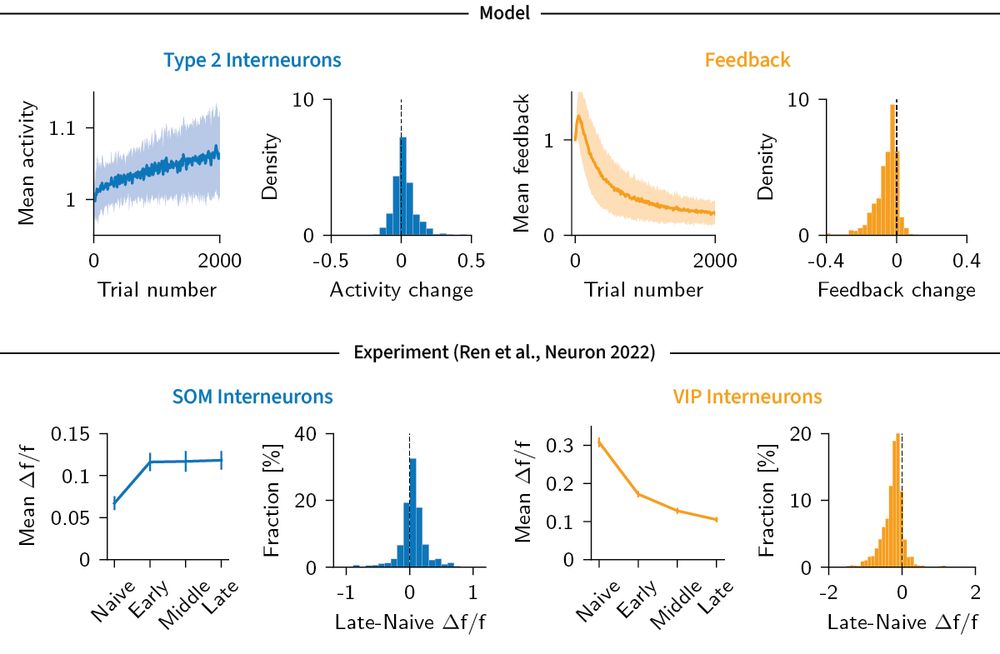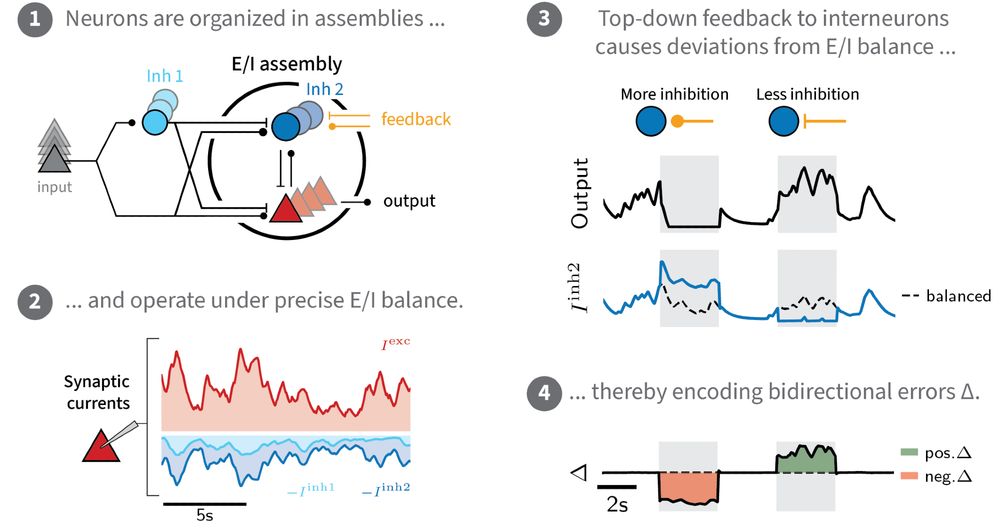Friedemann Zenke
@fzenke.bsky.social
Computational neuroscientist at the FMI.
www.zenkelab.org
www.zenkelab.org
Reposted by Friedemann Zenke
There might be a bit of misconception here. What the paper very convincingly shows is that visual cortex does not compute global oddball prediction errors and does not receive any top-down predictions that could be used to compute such prediction errors.
July 14, 2025 at 3:44 PM
There might be a bit of misconception here. What the paper very convincingly shows is that visual cortex does not compute global oddball prediction errors and does not receive any top-down predictions that could be used to compute such prediction errors.
Absolutely. The idea is that in addition to the very important role of keeping this delicate equilibrium, deviations from balance could serve yet another purpose.
May 28, 2025 at 8:37 AM
Absolutely. The idea is that in addition to the very important role of keeping this delicate equilibrium, deviations from balance could serve yet another purpose.
6/6 BCP does not only work. Trained networks also replicate in-vivo dynamics of SOM and VIP interneurons during motor learning and fear conditioning experiments. Our model takes a step toward linking neuronal circuits with plasticity and behavior.

May 27, 2025 at 7:51 AM
6/6 BCP does not only work. Trained networks also replicate in-vivo dynamics of SOM and VIP interneurons during motor learning and fear conditioning experiments. Our model takes a step toward linking neuronal circuits with plasticity and behavior.
5/6 In multi-layer networks, BCP enables online learning without separate training phases and segregated dendrites, while only using feedback-driven E/I balance perturbations.

May 27, 2025 at 7:50 AM
5/6 In multi-layer networks, BCP enables online learning without separate training phases and segregated dendrites, while only using feedback-driven E/I balance perturbations.
4/6 We formalize this idea as Balance-Controlled Plasticity (BCP), a plasticity framework grounded in adaptive control theory, which simplifies to a Hebbian-like learning rule modulated by recurrent inhibition. This learning rule is both biologically plausible yet powerful.

May 27, 2025 at 7:50 AM
4/6 We formalize this idea as Balance-Controlled Plasticity (BCP), a plasticity framework grounded in adaptive control theory, which simplifies to a Hebbian-like learning rule modulated by recurrent inhibition. This learning rule is both biologically plausible yet powerful.
3/6 We propose feedback signals may target interneurons to transiently disrupt E/I balance. These controlled deviations can efficiently encode local error signals, allowing to guide plasticity without the need for special dendritic morphology.

May 27, 2025 at 7:50 AM
3/6 We propose feedback signals may target interneurons to transiently disrupt E/I balance. These controlled deviations can efficiently encode local error signals, allowing to guide plasticity without the need for special dendritic morphology.
2/6 Existing theories of bio-plausible learning and credit assignment often rely on segregated dendrites to encode neuronal errors.
However, not all neurons have morphologically well-separated dendrites while data-driven plasticity models seem at odds with such error modulated learning.
However, not all neurons have morphologically well-separated dendrites while data-driven plasticity models seem at odds with such error modulated learning.
May 27, 2025 at 7:49 AM
2/6 Existing theories of bio-plausible learning and credit assignment often rely on segregated dendrites to encode neuronal errors.
However, not all neurons have morphologically well-separated dendrites while data-driven plasticity models seem at odds with such error modulated learning.
However, not all neurons have morphologically well-separated dendrites while data-driven plasticity models seem at odds with such error modulated learning.


